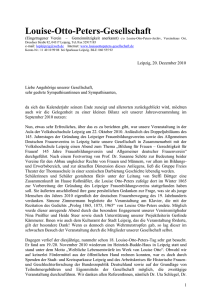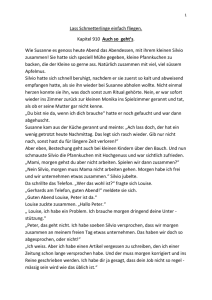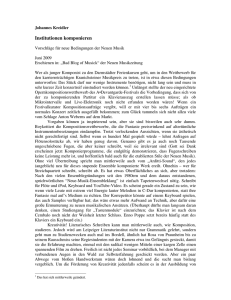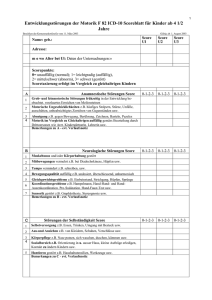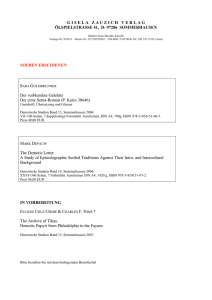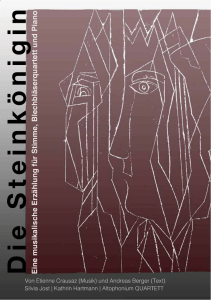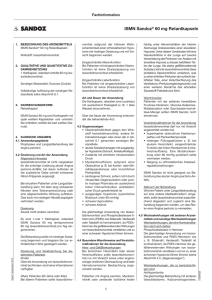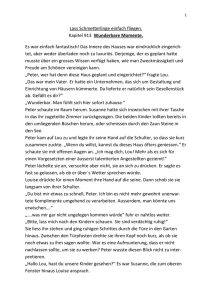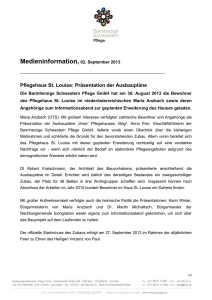Louise F arrenc
Werbung
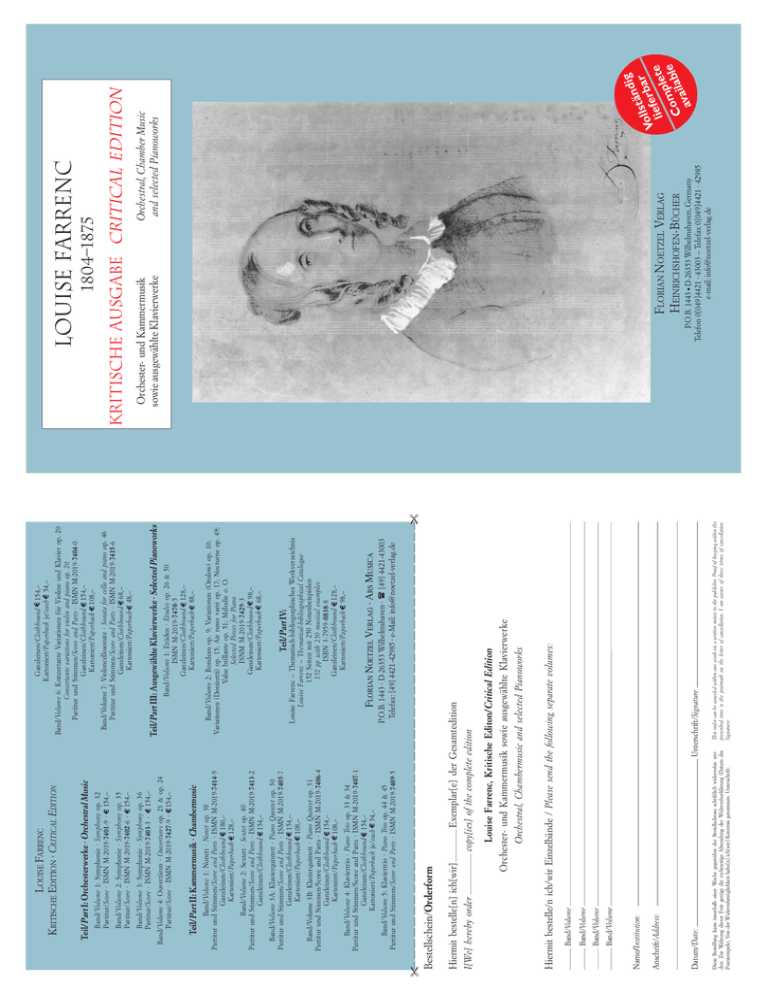
Orchestral, Chambermusic and selected Pianoworks Orchester- und Kammermusik sowie ausgewählte Klavierwerke Louise Farrenc, Kritische Editon/Critical Edition copy[ies] of the complete edition This order can be canceled within one week vis a written notice to the publisher. Proof of keeping within the prescribed time is the postmark on the letter of cancellation. I am aware of these terms of cancellation. Signature: Unterschrift/Signature Diese Bestellung kann innerhalb einer Woche gegenüber der Bestelladresse schriftlich widerrufen werden. Zur Wahrung dieser Frist genügt die rechtzeitige Absendung der Widerrufserklärung (Datum des Poststempels). Von der Widerrufsmöglichkeit habe[n] ich[wir] Kenntnis genommen. Unterschrift: Datum/Date: Anschrift/Address: Name/Institution: Band/Volume Band/Volume Band/Volume Band/Volume Hiermit bestelle/n ich/wir Einzelbände / Please send the following separate volumes: I[We] hereby order Hiermit bestelle[n] ich[wir] Exemplar[e] der Gesamtedition Band/Volume 5: Klaviertrio · Piano Trio op. 44 & 45 Partitur und Stimmen/Score and Parts · ISMN M-2019-7409-5 Bestellschein/Orderform FLORIAN NOETZEL VERLAG · ARS MUSICA P.O.B. 1443 · D-26353 Wilhelmshaven · [49] 4421-43003 Telefax: [49] 4421-42985 · e-Mail: info@ noetzel-verlag.de Louise Farrenc – Thematisch-bibliographisches Werkverzeichnis Louise Farrenc – Thematical-bibliographical Catalogue 152 Seiten mit 250 Notenbeispielen 152 pp with 250 musical examples ISBN 3-7959-0838-8 Ganzleinen/Clothbound 128,– Kartoniert/Paperback 98,– Teil/Part IV: Band/Volume 2: Rondeau op. 9; Variationen (Onslow) op. 10; Variationen (Donizetti) op. 15; Air russe varié op. 17; Nocturne op. 49; Valse brillante op. 51; Mélodie o. O. Selected Pieces for Piano ISNM M-2019-7429-3 Ganzleinen/Clothbound 98,– Kartoniert/Paperback 68,– Band/Volume 1: Etüden · Etudes op. 26 & 50 ISMN M-2019-7470-5 Ganzleinen/Clothbound 128,– Kartoniert/Paperback 88,– Teil/Part III: Ausgewählte Klavierwerke · Selected Pianoworks Band/Volume 7: Violoncellosonate · Sonata for cello and piano op. 46 Partitur und Stimmen/Score and Parts · ISMN M-2019-7415-6 Ganzleinen/Clothbound 68,– Kartoniert/Paperback 48,– Band/Volume 6: Konzertante Variationen für Violine und Klavier op. 20 Concertante variations for violin and piano op. 20 Partitur und Stimmen/Score and Parts · ISMN M-2019-7404-0 Ganzleinen/Clothbound 154,– Kartoniert/Paperback 108,– Ganzleinen/Clothbound 154,– Kartoniert/Paperback je/each 54,– Band/Volume 4: Klaviertrio · Piano Trio op. 33 & 34 Partitur und Stimmen/Score and Parts · ISMN M-2019-7407-1 Ganzleinen/Clothbound 154,– Kartoniert/Paperback je/each 54,– Band/Volume 3B: Klavierquintett · Piano Quintet op. 31 Partitur und Stimmen/Score and Parts · ISMN M-2019-7406-4 Ganzleinen/Clothbound 154,– Kartoniert/Paperback 108,– Band/Volume 3A: Klavierquintett · Piano Quintet op. 30 Partitur und Stimmen/Score and Parts · ISMN M-2019-7405-7 Ganzleinen/Clothbound 154,– Kartoniert/Paperback 108,– Band/Volume 2: Sextett · Sextet op. 40 Partitur und Stimmen/Score and Parts · ISMN M-2019-7413-2 Ganzleinen/Clothbound 154,– Band/Volume 1: Nonett · Nonet op. 38 Partitur und Stimmen/Score and Parts · ISMN M-2019-7414-9 Ganzleinen/Clothbound 180,– Kartoniert/Paperback 128,– Teil/Part II: Kammermusik · Chambermusic Band/Volume 4: Ouvertüren · Ouvertures op. 23 & op. 24 Partitur/Score · ISMN M-2019-7427-9 · 154,– Band/Volume 3: Symphonie · Symphony op. 36 Partitur/Score · ISMN M-2019-7403-3 · 154,– Band/Volume 2: Symphonie · Symphony op. 35 Partitur/Score · ISMN M-2019-7402-6 · 154,– Band/Volume 1: Symphonie · Symphony op. 32 Partitur/Score · ISMN M-2019-7401-9 · 154,– Teil/Part I: Orchesterwerke · Orchestral Music LOUISE FARRENC KRITISCHE EDITION · CRITICAL EDITION P.O.B. 1443 · D-26353 Wilhelmshaven, Germany Telefon 0[049]4421 · 43003 – Telefax 0[049]4421 · 42985 e-mail: [email protected] g ndi ä t r ls Vol eferba e t li p l e le m C o ailab av Orchestral, Chamber Music and selected Pianoworks FLORIAN NOETZEL VERLAG HEINRICHSHOFEN-BÜCHER Orchester- und Kammermusik sowie ausgewählte Klavierwerke Kritische Ausgabe Critical Edition 1804–1875 Louise Farrenc HENRI-LOUIS BLANCHARD described the 2nd Piano Quintet op. 31: This quintet is remarkable for its skill, the clarity of its ideas, its conceptual unity, the soundness of the partwriting, its taste and elegance of style, but above all for its abundance of melodic ideas, all of which imbue it with a delicious freshness. HENRI-LOUIS BLANCHARD über das 2. Klavierquintett op. 31: Dieses Quintett in E-Dur fällt auf durch seine Machart, die Klarheit der Themen, die Einheit der Konzeption, die saubere Imitationstechnik, durch seinen guten Geschmack, den eleganten Stil, vor allem aber durch die zahlreichen melodischen Einfälle, die sämtlich von köstlicher Frische sind Der erste Satz der Sinfonie in c-Moll . . . ist voll Wärme und Bewegung; im zweiten Teil hat Mme. Farrenc das Hauptthema mit großem Reichtum an Harmonien und Modulationen und mit einem seltenen Geschick für wirkungsvolle Instrumentierung verarbeitet. Das Adagio . . . enthält schöne Kantilenen und fällt durch vielfältige Klangkombinationen auf. Der Stil ist voller Weite und erhabe- Abb. umseitig: Louise Farrenc nach einer Zeichnung von Jean Bonaventure Laurens (1845). – The other page: Louise Farrenc after a drawing from Jean Bonaventure Laurens (1845). The first movement in E minor is full of warmth and movement; in the second part, Madame Farrenc has developed the main theme with a richness in harmony and modulation and a rare talent for effective instrumentation. The adagio...contains beautiful cantilenas which are phenomenal in their rich combination of sounds. The FRANÇOIS-JOSEPH FÉTIS wrote about the First Symphony op. 32: CONTEMPORARY CRITICS ZEITGENÖSSISCHE URTEILE FRANÇOIS-JOSEPH FÉTIS über die 1. Symphonie op.32: More than 20 of Farrenc’s 51 numbered opuses were originally devoted to piano music. In the Neue Zeitschrift für Musik (1836), ROBERT SCHUMANN referred to her Air russe varié, op. 17 as »small, neat, succinct studies (over which) a subtle aroma of romanticism hovers«. Beginning around 1840, LOUISE FARRENC turned to composing orchestral and chamber music. Having produced two overtures, three symphonies and numerous pieces of chamber music characterised by their intriguing instrumentation, she soon belonged to the small elite of French musicians who oriented themselves towards German classical and romantic music. Among her greatest triumphs were the 1849 premiere of her Symphony Nr. 3 op. 36, performed by the Société des concerts du Conservatoire and the 1850 premiere of Nonett op. 38, featuring the 19-year old violinist, JOSEPH JOACHIM. Twice, once in 1861 and once in 1869, LOUISE FARRENC was awarded the Prix Chartier by the Académie des BeauxArts. In 1860 LOUISE FARRENC and her husband, ARISTIDE FARRENC, began publishing the Trésor des pianistes. This 23-volume comprehensive collection of piano music from the 16th to the 19th centuries was instrumental in the revival and performance of Ancient Music. LOUISE FARRENC (1804–1875) studied under ANTON REICHA and worked in Paris for decades as a respected composer, pianist and music scholar. In 1842 she was the first woman to be appointed to the position of professor for piano at the Conservatoire National, a position she held for 30 years. Without question the most remarkable of all women who have devoted themselves to music composition...Her works bear witness to a power and richness of imagination as well as to a degree of knowledge which have never before been the attributes of a woman. Revue et gazette musicale, 1875 Über zwanzig ihrer insgesamt 51 mit Opuszahlen versehenen Kompositionen waren zunächst der virtuosen Klaviermusik gewidmet. ROBERT SCHUMANN nannte ihr Air russe varié op. 17 in der Neuen Zeitschrift für Musik 1836 »kleine, saubere, scharfe Studien«, über die »ein ganz leiser romantischer Duft« fortschwebe. Um 1840 wandte sich LOUISE FARRENC der Komposition von Orchester- und Kammermusik zu. Mit zwei Ouvertüren, drei Symphonien und zahlreichen Kammermusikwerken in reizvollen Besetzungen gehörte sie bald zur kleinen Elite derjenigen französischen Musiker, die sich an der deutschen Klassik und Romantik orientierten. Zu ihren großen Erfolgen zählten die Uraufführung der 3. Symphonie op. 36 durch die Société des concerts du Conservatoire 1849 und die Uraufführung des Nonetts op. 38 mit dem damals 19-jährigen Geiger JOSEPH JOACHIM im Jahre 1850. Zweimal, 1861 und 1869, wurde LOUISE FARRENC durch die Académie des Beaux-Arts mit dem Prix Chartier ausgezeichnet. Ab 1860 veröffentliche LOUISE FARRENC – zunächst zusammen mit ihrem Mann ARISTIDE FARRENC – den Trésor des pianistes, eine 23 Bände umfassende Sammlung von Klaviermusik des 16. bis 19. Jahrhunderts, die richtungweisend wurde für die Wiederbelebung und Aufführungspraxis Alter Musik. LOUISE FARRENC wurde von ANTON REICHA ausgebildet und wirkte jahrzehntelang in Paris als angesehene Komponistin, Pianistin und Musikgelehrte. 1842 wurde sie als erste Frau auf eine Klavierprofessur am Conservatoire national berufen, ein Amt, das sie 30 Jahre lang innehatte. Ohne Frage die bemerkenswerteste Frau, die sich je der Komposition gewidmet hat . . . Ihre Werke bezeugen eine Kraft und einen Reichtum an Fantasie sowie handwerkliche Fähigkeiten und Kenntnisse, wie sie vor ihr eine Frau niemals in gleichem Maße besessen hat. Revue et Gazette musicale, 1875 1804–1875 Louise Farrenc Einband der Ganzleinenbände Cover of the clothbound volumes Umschläge von kartonierten Ausgaben Cover of paperback editions Editionsleitung / Direction of this edition: Prof. Dr. Freia Hoffmann Dr. Christin Heitmann · Katharina Herwig · Dorothea Schenk This edition was made possible in part through a grant from the Deutsche Forschungsgemeinschaft (German Research Society) The Critical Edition of the Orchestral, Chamber Music and selected Pianoworks of Louise Farrenc is intended to advance academic work in this field as well as to contribute to the performance of Farrenc’s music. The manuscripts are based on contemporary sources, relying particularly on hand-written scores and first printings approved by the composer. This is the first time that most of these works have been made available in modern print. Each volume contains an explanation of the most important principles used in editing the manuscripts as well as a foreword with information concerning the circumstances surrounding the composition and first public performance of each work. In addition, each volume includes an appendix with information on the condition of the sources used. Whenever more than one version of a source was available, or when departures from the original sources were deemed necessary, this has been noted in the appendix. Each work includes the complete score as well as individual parts. Orchestral parts are available as rental material from the publisher. Die Kritische Ausgabe der Orchester- und Kammermusik sowie ausgewählter Klavierwerke LOUISE FARRENCS soll der wissenschaftlichen Arbeit ebenso wie der musikalischen Praxis dienen. Der Notentext basiert auf zeitgenössischen Quellen, vor allem Autographen und von der Komponistin betreuten Erstdrucken. Die meisten Werke werden mit dieser Edition erstmals in einem modernen Druck zugänglich gemacht. Jeder Band ist mit einer Erläuterung der wichtigsten Editionsprinzipien, einem Vorwort mit Angaben über Entstehungs- und Erstaufführungsumstände des betreffenden Werkes sowie einem Kritischen Apparat versehen, der im einzelnen Auskunft über Beschaffenheit der Quellen, Lesarten und Abweichungen vom Quellentext gibt. Für jedes Werk werden sowohl Partitur als auch Einzelstimmen vorgelegt. Orchesterstimmen sind jeweils als Leihmaterial beim Verlag erhältlich. Die Edition wird von der Deutschen Forschungsgemeinschaft unterstützt. NOTES ON THIS EDITION ZUR EDITION The first movement, characterised by absolute clarity and transparency, contains an outstanding second part in which details as well as overall themes have been developed to perfection. The andante with its variations is especially pleasing; the development of the melody is pure and simple, and the instruments are utilised to their best advantage. The underlying idea of the scherzo is a fortunate choice and its effect is picturesque. The finale is the crowning point of this important work. THÉRÈSE WARTEL described the Nonett op. 38: THÉRÈSE WARTEL über das Nonett op. 38 Der erste Satz, von vollendeter Klarheit und Durchsichtigkeit, enthält einen sehr bemerkenswerten zweiten Teil, in dem die Details und die thematische Arbeit meisterhaft gestaltet sind. Das Andante mit Variationen gefällt uns sehr; der Gang der Melodie ist rein und einfach, die Instrumente werden in vollkommener Weise zur Geltung gebracht. Das Scherzo ist . . . glücklich in der Idee und malerisch in der Wirkung. Das Finale schließlich ... krönt würdig dieses wichtige Werk. style is expansive and is brimming with lofty sentiment. I consider the minuet and the trio to be perfect movements due to their thematic arrangement, graceful development and fortunate utilisation of detail. The last movement, or finale, is characterised by warmth and passion. nen Gefühls . . . Menuett und Trio halte ich für vollendete Sätze aufgrund der Themengestaltung, der Anmut der Entwicklungen und glücklicher Details . . . Der letzte Satz, oder Finale, ist von warmem und leidenschaftlichem Charakter . . .
